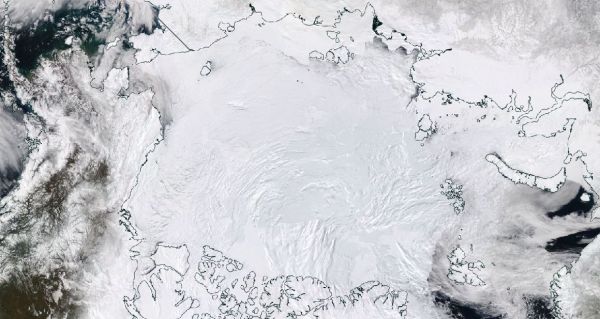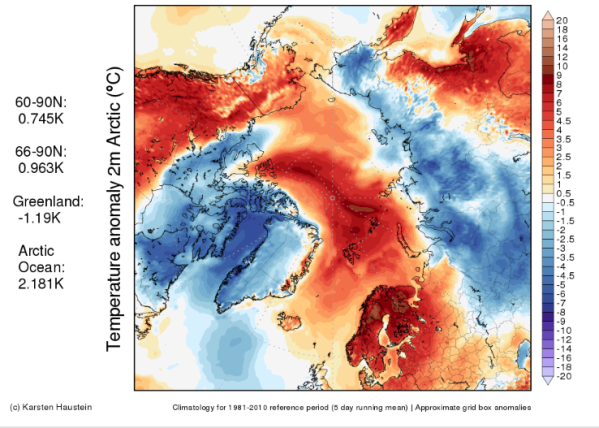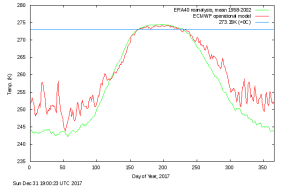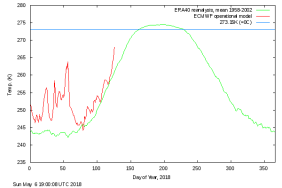Even when he's not talking about electric cars I no longer see Robertscribbler as a totally honest player
Arctic Ocean Deep in the Grips of May Temperature Spike; Beastly Summer Melt Season on the Way?
7
May, 2018
The
Arctic sea ice is presently at
its second lowest extent ever recorded in most of the major monitors.
However, May is shaping up to be far,
far warmer than normal for the Arctic Ocean region.
If such high temperatures over this typically-frozen part of our
world continue for much longer than a couple of weeks at this key
time of year, precipitous summer melt is sure to follow.
******
During
recent years there has been much speculation about when the Arctic
Ocean will start to experience ice-free summers as fossil fuel
related industries pump higher and higher volumes of greenhouse
gasses into the atmosphere. In the early-to-mid 2000s, scientific
consensus was that melt would tend to be more gradual and ice-free
summers would hold off until the final decades of the 21st Century
when the world was around 3-4 C warmer than 19th Century averages.
But
the Earth System is far more sensitive to temperature increases than
the early forecasts expected. Major Arctic sea ice losses surprised
the world during September of 2007 and subsequently in the same month
of 2012. Now, it is obvious that a pattern of far more rapid sea ice
melt has taken hold. And the scientific consensus appears to have
settled on a more likely and much nearer date around the early 2030s
— when the world will have warmed by about 1.6 degrees Celsius.
However,
when it comes to sea ice, nothing is certain at this time. Any single
Arctic year in which temperatures spike — particularly during
normal melt season — could result in the losses that we once
expected to occur much later in time.
There
are many factors that will ultimately determine when a summer ice
free state occurs. Warm winters are a major one. And the past two
years (2017 and 2018) have
seen Arctic winters in which temperatures hit some ridiculous high
extremes.
But another major factor is the set-up to Arctic summer that takes
place during the window months of May and June.
May and June are very important for the rest of the melting season. Not only do we now see these warm air intrusions, but high pressure maintains its presence over parts of the Arctic as well (which means relatively cloudless skies -> insolation -> melt onset and melt pond formation -> preconditioning of the ice pack -> melting momentum that gets expressed during July and August, regardless of the weather)… We have to wait and see what happens, step by step, but this isn’t a good start for the ice.
If
May and June are unusually warm, particularly over the Arctic Ocean,
then the sea ice — which is already greatly weakened — is bound
to face an extended period of above-freezing temperatures. If such a
period stretches for 5 months from May through September rather than
the typical 4 months (June to September), then we are more likely to
see the Arctic Ocean briefly flip into an ice-free or near ice-free
state for the first time in human history.
(The
coming week is expected to feature between 1 and 10 C above average
temperatures for locations across the Arctic Ocean. These are very
strong warm departures during May. Last week saw similar extreme warm
departures. And we are already starting to see sea ice losses pile
up. Image source: Global
and Regional Climate Anomalies.)
This
year, May is shaping up to be much, much warmer than normal for the
High Arctic. Already, a large May temperature spike has occurred (see
right image below). A
temperature spike which is predicted to continue for at least the
next ten days.
Not
to put too fine a point on it, but this severe warming trend might
end up presenting a bit of a problem. The extended period of melt
mentioned above may begin in force — setting off a chain of
feedbacks that could tip the Arctic Ocean into a far less frozen or
even an ice-free state (under absolute worst case scenarios) this
year.
To
be clear, this is not a forecast that such a condition is bound to
occur during 2018. It is just an analysis of underlying trends and a
statement that risks are higher if such trends as we now observe
continue. Late May could flip to a cooler than normal regime. June
could be cooler and cloudier than normal (as happened during 2016 and
2017). And if that happens again, we may be spared.
(Average
Arctic temperatures for 2017 [left] and 2018 [right]. The red line
depicts the yearly temperature trend. The green line depicts the
Arctic climatological average for 1958-2002 [which was already warmer
than normal]. Note the big temperature spike in the right hand graph.
That’s where we are now. Image source: DMI.
For further reference, see Zack
Labe‘s composite
temperature analysis for
the 80 North region.)
However,
we are already on a much higher ramp for spring temperatures in the
northern polar region than during 2017. And though 2016
saw a slightly warmer than normal spring near the pole,
the May 2018 spike already far exceeds anything we saw at that time.
So much, in fact, that present temperatures for May 6 are comparable
to those typically seen during early June from the 80 degree N
Latitude line to the Pole.
This
higher ramp and related record warmth is already accelerating
melt. Sea
ice losses over recent days have greatly picked up and
we are getting closer to record low daily ranges. If melt accelerates
to a point, the greatly expanded darker ocean surfaces will draw in
more heat from the sun’s rays during June — potentially
overcoming the impact of the increased early summer cloudiness we
have seen during recent years. Such a scenario, if it continues to
develop, would be a nightmare from the climate change perspective.







No comments:
Post a Comment
Note: only a member of this blog may post a comment.